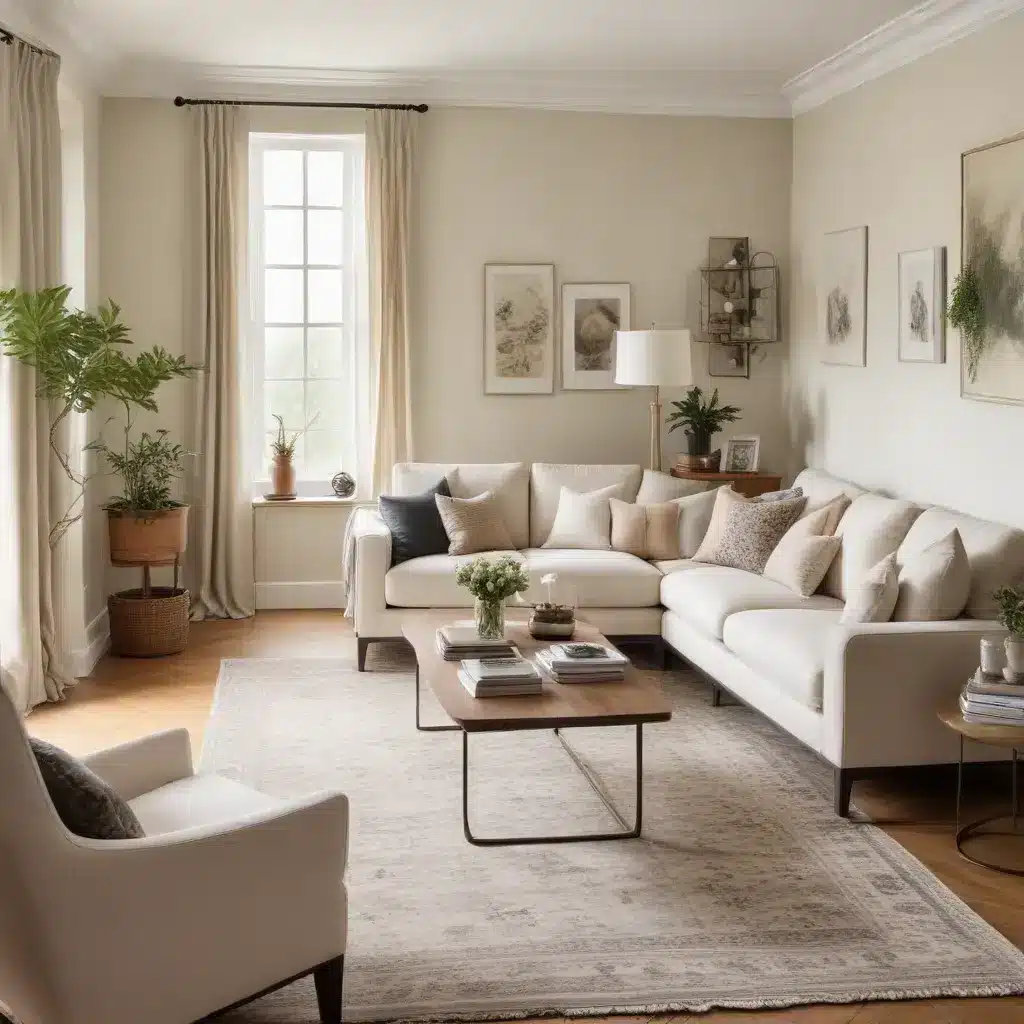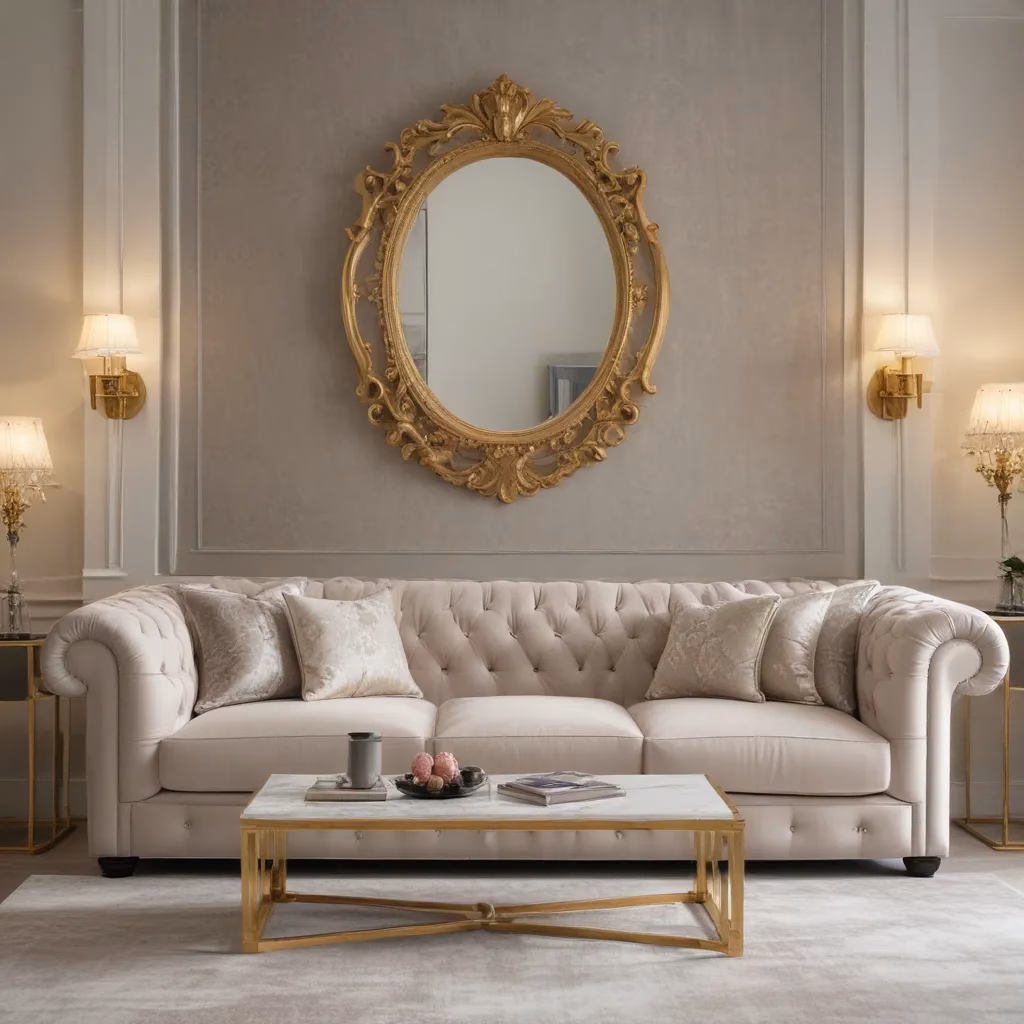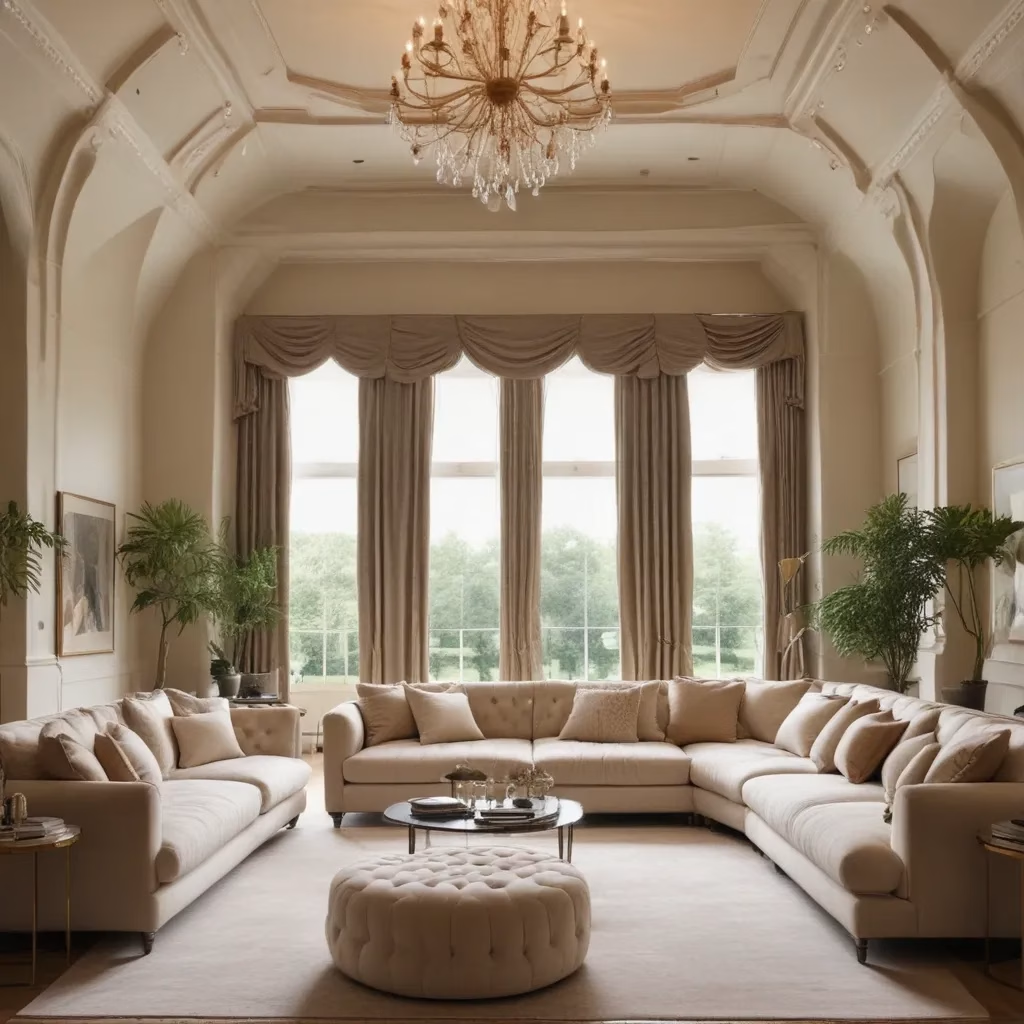
As a seasoned furniture specialist, I’ve seen countless living rooms transformed from cluttered, uninspiring spaces into inviting havens of comfort and style. Over the years, I’ve learned that the key to a well-designed living room lies not just in selecting the right pieces, but in arranging them in a way that maximizes both form and function. Today, I’m excited to share some of my favorite strategies for effortless furniture arrangement that will help you reimagine your living space.
Understanding the Basics of Furniture Layout
When it comes to arranging furniture in your living room, it’s essential to start with a solid foundation. As I always tell my clients, the layout of your room is like the skeleton of your design – it provides structure and support for everything else.
First and foremost, consider the flow of traffic through your space. You want to create clear pathways that allow people to move easily from one area to another without obstacles. I remember working with a client whose living room felt cramped and difficult to navigate. By simply repositioning their sofa away from the main walkway, we opened up the entire space and made it feel much more inviting.
Another crucial aspect of furniture layout is creating a focal point. This could be a fireplace, a large window with a beautiful view, or even a statement piece of artwork. Once you’ve identified your focal point, arrange your furniture to highlight it. For example, in a recent project, we centered a gorgeous velvet sofa from Sofa Spectacular facing a stunning bay window, instantly drawing the eye to the panoramic view outside.
Lastly, don’t forget about conversation areas. A well-designed living room should facilitate interaction and comfort. Try arranging seating in a way that allows people to face each other easily. U-shaped or circular arrangements often work well for this purpose.
Choosing the Right Sofa for Your Space
The sofa is often the centerpiece of a living room, so selecting the right one is crucial. When I’m working with clients, I always emphasize the importance of considering both style and functionality.
Size is a critical factor. A sofa that’s too large can overwhelm a small room, while one that’s too small might look out of place in a spacious area. I always recommend measuring your space carefully before making a purchase. Don’t forget to account for walkways and other furniture pieces!
Style is another important consideration. The sofa you choose should complement the overall aesthetic of your room. For a modern, minimalist space, you might opt for a sleek leather sofa with clean lines. In a more traditional setting, a tufted fabric sofa could be the perfect choice.
Comfort is paramount when it comes to sofas. After all, this is where you’ll likely spend a lot of time relaxing. I always encourage my clients to test out sofas before buying. Sit on them, lie down, and really get a feel for the comfort level. Remember, a sofa that looks great but feels uncomfortable won’t get much use.
Durability is another factor to consider, especially if you have children or pets. Look for high-quality materials and construction that can withstand daily use. Leather and certain synthetic fabrics tend to be more durable and easier to clean than delicate fabrics like silk or linen.
Mastering the Art of Furniture Grouping
Once you’ve chosen your key pieces, it’s time to think about how to group them effectively. Furniture grouping is an art that can dramatically impact the look and feel of your living room.
One strategy I often use is the concept of “floating” furniture. This means pulling pieces away from the walls to create more intimate seating areas. For example, in a large living room, you might create two separate conversation areas – one centered around the TV for movie nights, and another near a window for reading or chatting.
Balance is key when grouping furniture. Try to distribute visual weight evenly around the room. If you have a large sectional on one side, balance it with a couple of armchairs or a loveseat on the other. This creates a sense of harmony and prevents the room from feeling lopsided.
Don’t be afraid to mix and match different styles of furniture. A contemporary sofa can look fantastic paired with vintage armchairs, creating an eclectic and personalized look. The key is to find a common thread – perhaps a color or material – that ties everything together.
Incorporating Multi-functional Furniture
In today’s homes, where space is often at a premium, multi-functional furniture can be a game-changer. I’ve seen firsthand how clever, dual-purpose pieces can transform a living room from cramped to comfortable.
Ottomans are one of my favorite multi-functional pieces. They can serve as extra seating, a coffee table, or even hidden storage. I once worked with a family who needed more seating for gatherings but didn’t want to clutter their small living room. We found a beautiful, large ottoman that could be used as a coffee table day-to-day, but also provided additional seating when guests came over.
Sofa beds are another excellent option for those who need to accommodate overnight guests but don’t have a dedicated guest room. Modern sofa beds have come a long way in terms of comfort and style. I recently helped a client choose a sleek, contemporary sofa bed that looked nothing like the clunky pull-out couches of the past.
Storage furniture is also invaluable in a living room. Coffee tables with drawers, side tables with shelves, and even sofas with built-in storage can help keep your space organized and clutter-free.
Maximizing Small Spaces
Working with small living rooms presents unique challenges, but with the right strategies, you can create a space that feels both functional and spacious.
One of my go-to tricks for small spaces is using furniture with exposed legs. This might seem counterintuitive, but furniture that sits up off the floor actually creates a sense of openness and airiness. A sofa or armchair with visible legs allows you to see more of the floor, making the room feel larger.
Mirrors are another fantastic tool for making a small space feel bigger. A large mirror on one wall can visually double the size of your room. I once worked on a tiny studio apartment where we placed a floor-to-ceiling mirror opposite the window. The effect was stunning – it reflected light throughout the space and made the room feel twice as large.
In small living rooms, every inch counts. Look for slim profile furniture that doesn’t take up too much visual space. A streamlined sofa or loveseat can provide comfortable seating without overwhelming the room.
The Role of Color in Furniture Arrangement
Color plays a crucial role in how we perceive space, and it can be a powerful tool in furniture arrangement. When used strategically, color can help define areas, create focal points, and even influence the mood of your living room.
One technique I often use is creating a color scheme based on the largest piece of furniture in the room – usually the sofa. If you have a neutral-colored sofa, you have the flexibility to introduce bolder colors through accent chairs, throw pillows, or artwork. Conversely, if your sofa is a vibrant color, you might want to keep the rest of the room more subdued to create balance.
Don’t be afraid to use color to define different areas within your living room. For example, you might use warm tones like reds and oranges in your conversation area to create a cozy, intimate feel, while using cooler blues and greens in a reading nook for a more calming atmosphere.
Remember that color isn’t just about the furniture itself. The color of your walls, flooring, and even your ceiling can impact how your furniture looks and feels in the space. I always encourage my clients to consider the room as a whole when making color decisions.
Lighting: The Unsung Hero of Furniture Arrangement
Lighting is often overlooked in furniture arrangement, but it can make or break the ambiance of your living room. Good lighting not only illuminates your space but also highlights your furniture and creates atmosphere.
When arranging furniture, always consider the natural light sources in your room. Position seating areas to take advantage of windows, but be mindful of glare on screens. In one project, we repositioned a client’s TV to avoid the afternoon sun, which had been making it difficult to watch during certain hours of the day.
Layer your lighting for maximum effect. I recommend having at least three light sources in any living room: ambient lighting for overall illumination, task lighting for activities like reading, and accent lighting to highlight architectural features or artwork.
Table lamps are a fantastic way to add both light and style to your living room. Place them on side tables next to seating for convenient task lighting. Floor lamps can be used to illuminate dark corners or create a cozy reading nook.
Don’t forget about the height of your lighting fixtures. A common mistake I see is hanging pendant lights or chandeliers too high. As a general rule, the bottom of a hanging light fixture should be about 30-36 inches above a table or 7 feet above the floor in open areas.
The Importance of Negative Space
While it’s tempting to fill every inch of your living room with furniture and decor, negative space – the empty areas in your room – is crucial for creating a balanced and harmonious layout.
Negative space gives the eye a place to rest and prevents your room from feeling cluttered or overwhelming. It also allows your key pieces to stand out and be appreciated. I often tell my clients, “Sometimes, less really is more.”
One way to incorporate negative space is by leaving some walls bare. You don’t need to hang artwork on every available surface. A strategically placed empty wall can create a sense of spaciousness and serenity.
Another technique is to create breathing room around your furniture. Don’t push every piece up against a wall or right next to another piece. Allow for some space between items to create a more open and inviting feel.
Remember, negative space doesn’t have to be completely empty. A large area rug can define a seating area while still providing visual “breathing room” around the furniture.
Personalizing Your Space
While following design principles is important, don’t forget that your living room should reflect your personal style and needs. The most successful living room designs are those that balance functionality with the homeowner’s unique personality.
One way to personalize your space is through accessories. Throw pillows, blankets, and decorative objects are easy ways to inject your personal style into your living room. I always encourage my clients to display items that have special meaning to them – whether it’s a collection of travel souvenirs or family heirlooms.
Don’t be afraid to break the rules sometimes. If a particular arrangement feels right to you, even if it goes against conventional wisdom, go for it! I once worked with a client who insisted on placing their sofa at an angle in the corner of the room. While it wasn’t a traditional layout, it ended up creating a unique and inviting space that perfectly suited their needs.
Remember that your living room should evolve with you. As your life changes, don’t be afraid to rearrange your furniture or swap out pieces to better suit your current lifestyle.
Maintenance and Care for Your Furniture
Once you’ve created your perfect living room layout, it’s important to maintain your furniture to keep it looking its best. Regular care can extend the life of your pieces and keep your living room looking fresh and inviting.
For upholstered furniture, regular vacuuming is essential to remove dust and debris. Use the upholstery attachment on your vacuum cleaner to gently clean the surface of your sofa and chairs. For leather furniture, dust regularly with a soft, dry cloth.
Treat spills immediately to prevent staining. Blot – don’t rub – the spill with a clean, white cloth. For tougher stains, consult the manufacturer’s cleaning instructions or seek professional help.
Rotate cushions regularly to ensure even wear. This is especially important for sofas and chairs that get heavy use. I recommend flipping and rotating cushions every few weeks.
Protect your furniture from direct sunlight, which can cause fading. Use window treatments to filter harsh light, or consider rearranging your furniture periodically to prevent uneven fading.
Adapting Your Layout for Different Occasions
One of the beauties of a well-planned living room is its ability to adapt to different occasions. With a little forethought, you can create a flexible space that works for everyday living as well as special events.
For everyday use, arrange your furniture to support your regular activities. This might mean creating a cozy conversation area, a space for watching TV, or a quiet reading nook.
When entertaining, consider how you can rearrange your furniture to accommodate guests. Perhaps you can move your coffee table to the side to create more standing room, or bring in extra seating from other rooms.
For larger gatherings, you might want to create multiple conversation areas. This can be as simple as turning armchairs to face each other or bringing in ottomans or poufs for additional seating.
Don’t forget about traffic flow when rearranging for events. Ensure there are clear paths for people to move around, especially if you’re serving food or drinks.
The Future of Living Room Design
As we look to the future, it’s exciting to consider how living room design and furniture arrangement might evolve. Technology is already playing a bigger role in our homes, and this trend is likely to continue.
Smart furniture, which can charge our devices or even change shape to suit different needs, is becoming more common. I recently worked with a client to incorporate a smart coffee table into their living room design. The table not only provided a sleek surface for drinks and books but also featured built-in charging ports and a lift-top that could transform it into a work surface.
Sustainability is another important trend in furniture design. More and more of my clients are looking for eco-friendly options, from sofas made with recycled materials to vintage pieces that have been lovingly restored.
Virtual and augmented reality tools are also changing the way we plan our living spaces. These technologies allow us to visualize different furniture arrangements and color schemes before making any purchases or moving any furniture.
As our homes continue to serve multiple functions – from living spaces to home offices to entertainment centers – flexibility in furniture and layout will become increasingly important. Modular furniture that can be easily rearranged or repurposed is likely to gain popularity.
Whatever the future holds, I believe the fundamental principles of good design will remain the same. Creating a living room that is both beautiful and functional, that reflects your personal style while meeting your practical needs, will always be the goal.
In conclusion, reimagining your living room through thoughtful furniture arrangement is a powerful way to transform your space. By understanding the basics of layout, choosing the right pieces, and arranging them strategically, you can create a living room that is both beautiful and functional. Remember, there’s no one-size-fits-all solution – the best layout for your living room is one that reflects your personal style and meets your unique needs. So don’t be afraid to experiment, move things around, and make your living room truly your own. Happy decorating!



